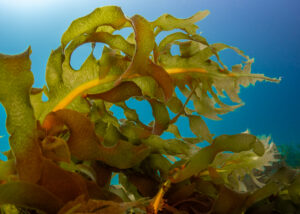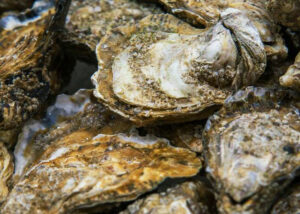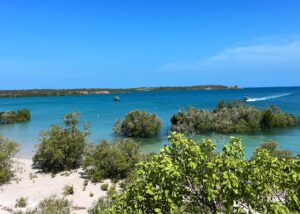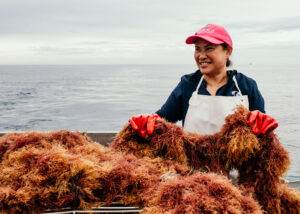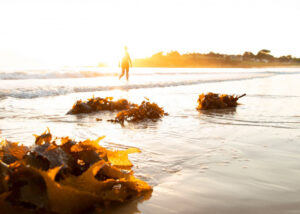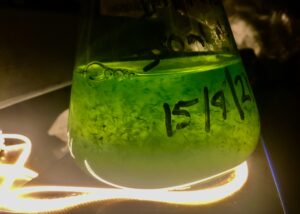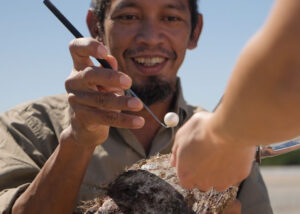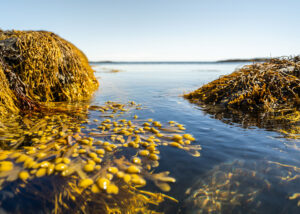Oyster pheromones, human gamete health and ‘oyster sex dipsticks’
Researchers at the University of The Sunshine Coast are lifting the lid on the Sydney rock oyster to reveal a treasure trove of peptides. If only they weren’t so damned difficult to work with…
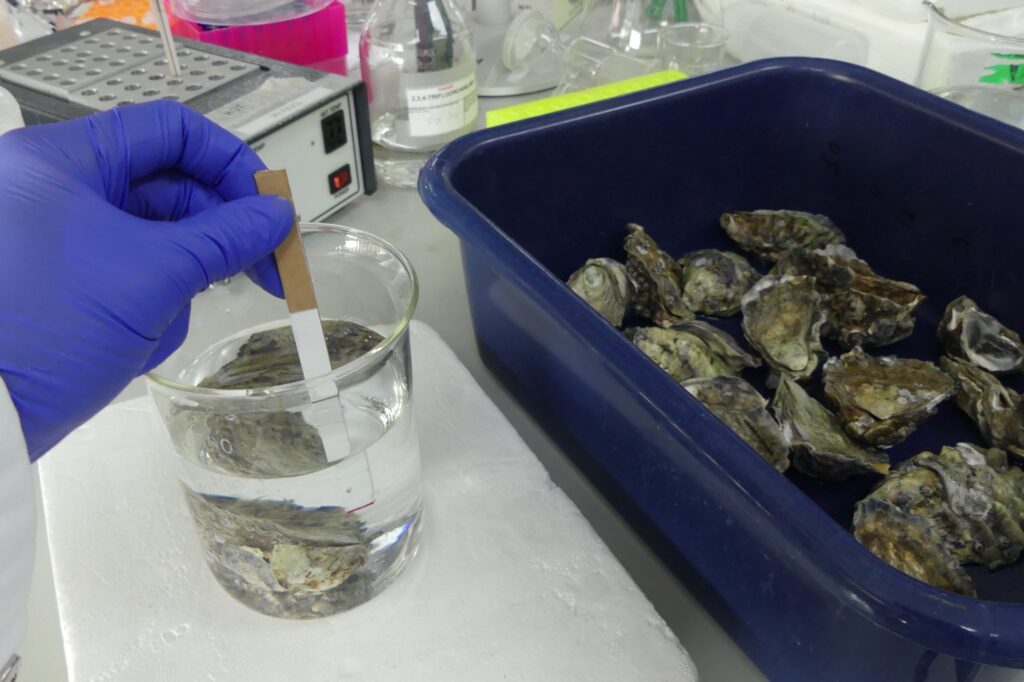
Sydney Rock Oysters of unknown gender. A dipstick that could be used to determine gender based on differences in biomolecules secreted by the oyster into the water.
When you’re next looking at a shucked oyster, you may be fascinated (or appalled) by the fact that half of what you’re seeing is a sex gland. You may also be tickled to learn that it’s almost impossible to tell the sex of an oyster – and that the oyster’s reputed aphrodisiac properties may one day have real implications for human reproductive health.
Professor Scott Cummins is a researcher at the University of the Sunshine Coast (UniSC). He and his team are part of the university’s Centre for Bioinnovation, where they’ve discovered some 20 molecules thought to encourage reproduction in Sydney rock oysters.
“Like many species, oysters don’t always do as well in a non-natural environment as they do in the wild,” he says. “One way we can improve reproduction in hatcheries is at the spawning stage. So, we’re looking at natural products – hormones or peptides – that we can give to oysters to ensure that they spawn and produce more babies.”
With the world’s oyster aquaculture industry worth an estimated US$8bn, being able to increase the fertility of farmed oysters and control when they spawn would prove hugely valuable. Unfortunately for growers – and indeed scientists – oysters can be anything but cooperative.
“I like eating oysters, but it can be challenging working with them!” says Scott. “They have this closed challenge. They’re difficult to manipulate and, behaviourally speaking, they don’t give you much information.”
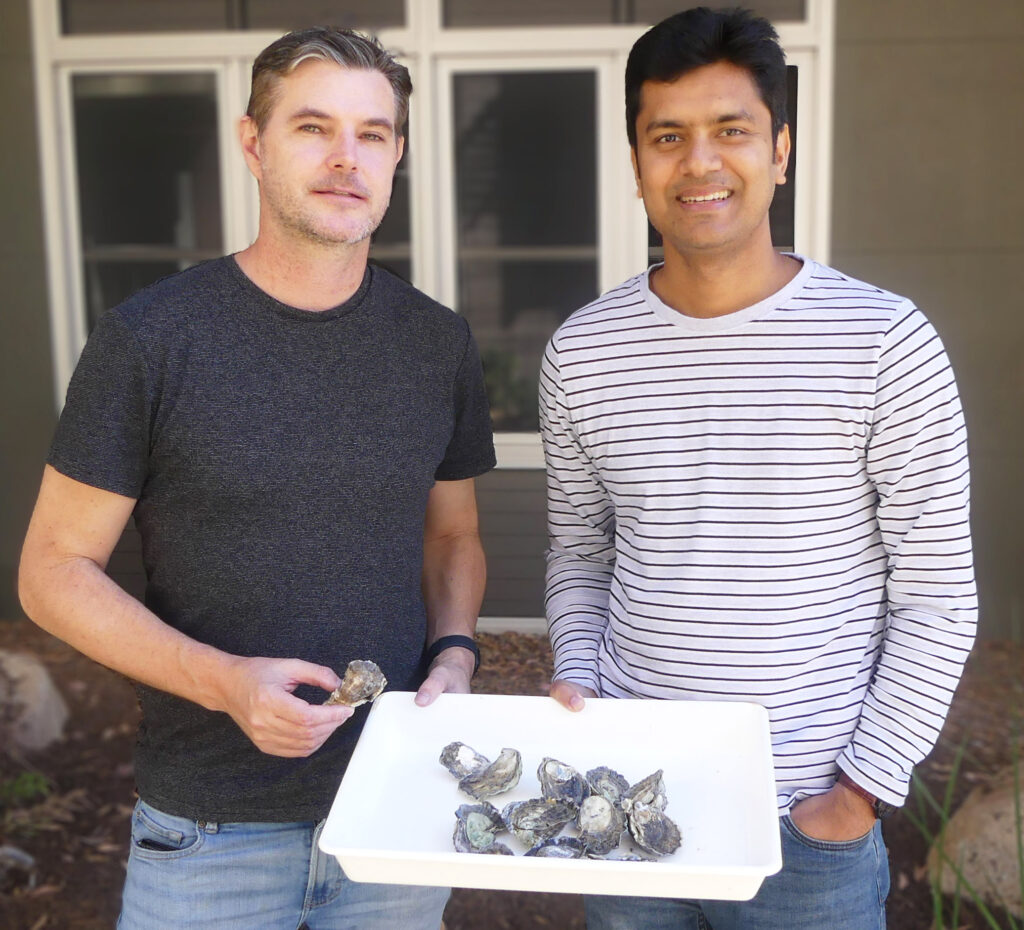
Professor Scott Cummins and Md Abu Zafar with Sydney Rock Oysters
Ten years ago, the UniSC Center for Biodiscovery team under Professor Abigail Elizur was commissioned to find ways to improve reproductive condition and spawning success in populations of Sydney rock oysters (SROs). The NSW Department of Primary Industry was especially keen to breed the native species – not only to allow farmers year-round access to stock, but also to boost productivity through faster growth and disease-resistance.
The team soon found itself up against a whole suite of challenges.
It’s impossible to tell the sex of an oyster – at least not without laborious anaesthetisation and biopsy. To make the business of breeding oysters even more difficult, oysters can change sex as they mature (male to female), but there’s no guarantee this will occur. Basically, researchers – and growers – are blind as to the sex of the animals they’re trying to encourage to breed.
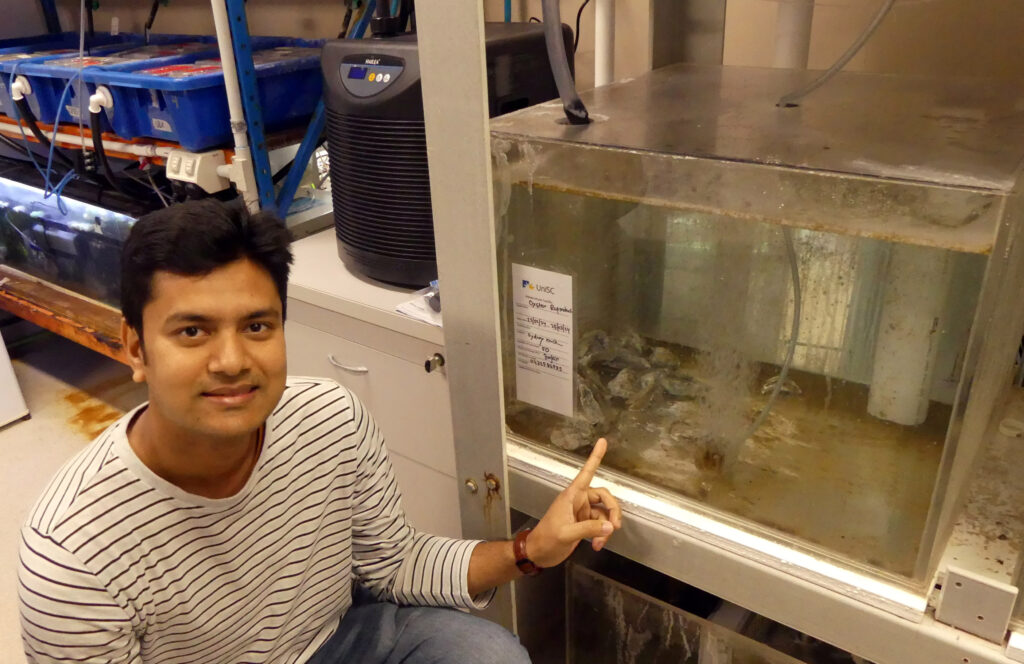
PhD student Md Abu Zafar with a Sydney Rock Oyster aquarium
Scott explains most hatcheries currently rely on one of two methods to induce spawning.
The most common is a simple ‘stress treatment’. When the timing is right, they take their preferred breeders (broodstock) and subject them either to a decrease in salinity or to a mild heat treatment. These stress treatments aren’t ideal. “It doesn’t work for individuals, it has to be mass spawnings and you can’t control who fertilises who.”
The other technique is to ‘strip spawn’, which involves opening the shell and removing the sperm and eggs from the gonad. This allows control of parents, but it too, is unsatisfactory: farmers have to kill their valuable breeding stock, and it’s a coin-toss whether they’re opening the shell of a male or a female, increasing wastage. Further, there is a greater likelihood that the gametes are immature and the crosses simply don’t fertilise properly.
In 2015, the UniSC team made a breakthrough when it identified a neuropeptide that can be injected into the invertebrate and ‘push’ the animals to spawn.
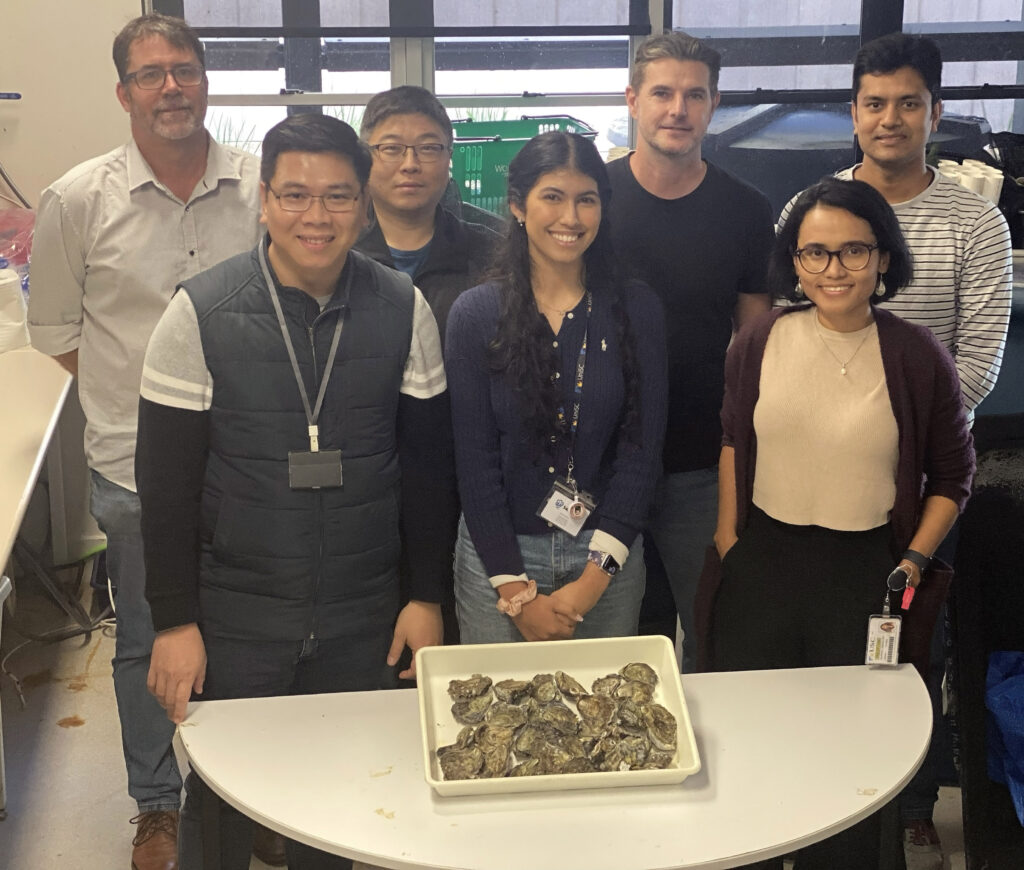
The University of the Sunshine Coast team who are studying the Sydney Rock Oysters. From left to right: A/Prof David McMillan, Dr Trong Tran, Dr Tianfang Wang, Jessica Gibbs (Masters student), Prof Scott Cummins, Dr Saowaros Suwansa-Ard, Md Abu Zafar (PhD student)
“It’s a very specific hormone which we can give them and – bang! – they spawn. Oysters are a broadcast spawner, which means both sexes release their gametes into the water; this hormone encourages oysters to spawn, but critically only encourages the release of mature sperm and eggs.
“Unfortunately, administering the hormone isn’t easy. We give them an anesthetic, so they relax and open up their shell, which allows us to then inject the hormone into their muscle. If you do that on a few hundred oysters, it’s really time-consuming! We can also drill a hole in the shell but that can introduce bacterial and parasite infections.”
The team decided it would be better for everyone if a pheromone could be found – a neuropeptide that could be introduced to the water and push the animals to spawn.
“We knew that if you introduce oyster sperm to the water, it induces spawning. So we thought there might be something on the surface of the sperm that was acting as a trigger.”
Using centrifugation and high-performance liquid chromatography, the team isolated more than a thousand molecules from sperm cells. These were then tested on batches of live oysters to see how well each performed as a pheromone.
“After 10 years, we’re super close to identifying the molecule,” says Scott. “We’re down to about 20 peptides.”
At this point you begin to appreciate Scott’s frustration with oysters. During the trials, he and the team tested the molecules on small batches of oysters, however testing was limited to only five month-long spawning seasons and only during a full moon. Worse, the team had to trust to nothing more than hope that their oyster batches had a reasonable mix of males and females.
Two years ago, perhaps goaded by frustration, they opened a new branch of research to overcome the profound obstacle of working blind on the sex of oysters.
“We set about developing a dipstick – a noninvasive approach to telling the sex of an oyster. Think of it like a stick you’d use to test for human pregnancy, or a strip you’d dip into a swimming pool to test for chlorine.”
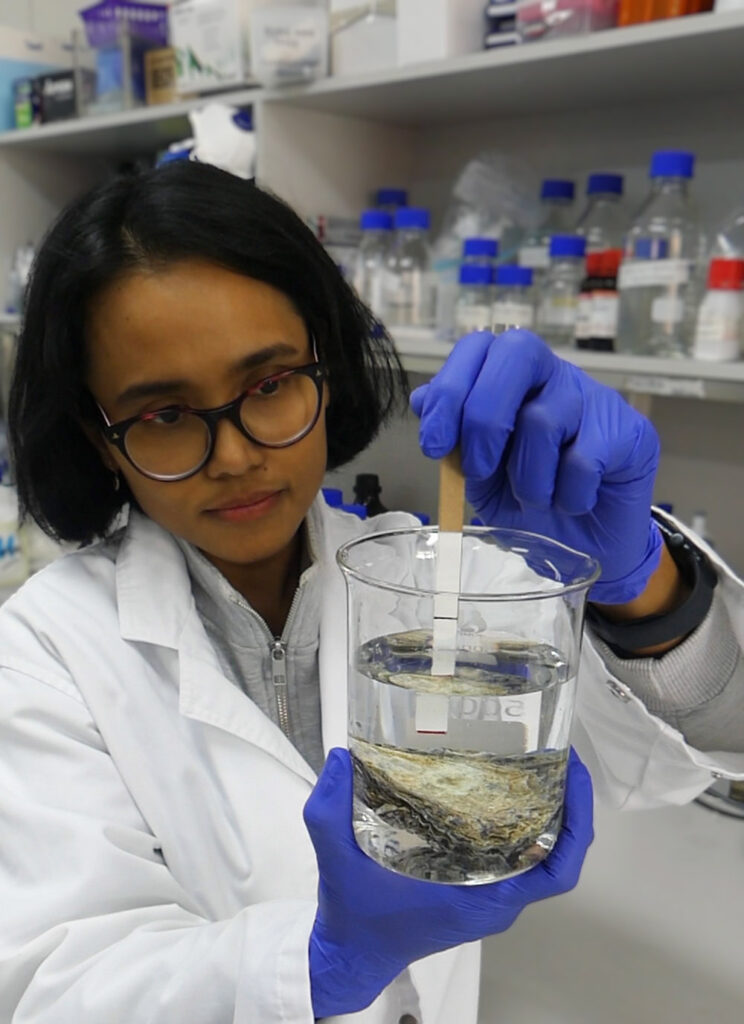
A Sydney Rock Oyster of unknown gender. Dr Saowaros Suwansa-Ard uses a dipstick that could determine gender based on biomolecules secreted by the oyster into the water.
In conjunction with MBCRC partner PhD researcher Zafar Abu and Dr Saowaros Suwansa-ard, the hunt began for pheromones being shared between oysters through the water. “These pheromones effectively say ‘I’m a male’, ‘I’m a female’, and even ‘I’m at maturation stage’. And again, we’ve narrowed it down to where we’re confident we can detect the differences in sex.”
The next step is the technicalities of making the dipstick, which Scott describes as an exciting stage. “There’s 100% market for it. And not just within oyster farming, there are other species that don’t show sexual dimorphism, including sea cucumbers, which is a vast market. No-one’s developed anything like this anywhere in the world.”
As a value proposition, the potential for work in spawn pheromones and sex testing is huge. But it pales in comparison if UniSC and research partners at Flinders University can use extractions developed from SROs to improve fertility in human beings.
Also in conjunction with the MBCRC at Flinders University, a team under Professor Chris Franco and Dr Qi Liang is beginning preclinical trials using the UniSC developed SRO extractions, including zinc-rich peptides.
According to Dr Qi, “The gonad in the organism is where all the good substance is. It produces a lot of zinc, which we know is useful in reproduction – and probably where the ‘oyster as aphrodisiac’ belief comes from. So, we’ve started asking whether it could help with the proliferation of human gametes.
“We’ve been working on cell lines but are planning to progress the research to mice. At this point we’re being scientific and open – it’s about biodiscovery. We’re testing the molecules we’ve purified, and many of them have never been identified before.”
This will be the first time these molecules have been investigated within animals to evaluate their activity toward fertility improvement, sex hormone production and delay in reproductive aging. “We aim to produce novel and robust scientific evidence for reproductive health products that benefit human health,” says Dr Qi.
“We believe you’ll never look at an oyster the same way again.
Would you like to be featured in Just One Drop? We are always keen to promote our Partners, your research and project outcomes. Please get in touch – we would love to hear from you!



